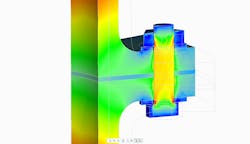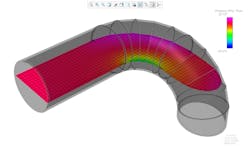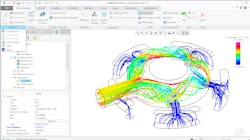In Praise of Simulation—and Why You Should be Using It
Looking back a couple of decades, it was really only the big aerospace and automotive companies that got the most value out of simulation, or even attempted it. That’s no longer true. Now, every organization—and the design engineers in those organizations—can get value and should be using it. You’re missing out if you don’t, and even more so when your competitors do!
Simulation has been democratized. It’s no longer entirely the preserve of degreed specialists with mysterious and intimidating skills. It’s evolved to serve a broader audience. Here’s the good news: The marketplace recognized the need for simulation tools that can be used during the design phase and moved to fill that gap. Simulation exists not as a separate branch, as a sort of perpendicular activity, but as one that you do while you’re building geometry and developing your design.
Think of it this way: if you’re balancing a household checkbook or doing the finances for a company, you don’t write all the numbers down then at the end go and see if they add up. You perform the calculations as you go so that you can get to the end with more confidence.
Yet it’s no secret that adoption isn’t universal. In my career, I’ve come across a few recurring reasons for this. Some design engineers don’t have a clear idea of the benefits. Prototypes have the final say, after all. Others don’t think the tools will suit them. They believe they’ll still have to go back and forth with the analysts (or worse still, have to go back to school).
Lastly, a major concern that crops up is one that many of us who work in demanding professions don’t like to admit: Oh no, a new tool to learn! That’s the last thing I need when I’m trying to get my own job done against budget cuts, deadlines, and considerable design challenges.
The reality, though, is that you can’t afford not to. Simulation tools allow you to find and fix design flaws as they appear, when you can resolve them by making small changes within the digital world. That’s more appealing than large prototyping bills, periods of waiting, frustration, and potentially a trip back to the proverbial drawing board.
It’s been said “If you can’t take the heat, get out of the kitchen.” With simulation tools, you avoid that metaphorical kitchen in the first place.
If you’ve ever asked a “what-if” question, then you have already opened the door to simulation’s benefits. I need to get this large couch up to the second floor via the staircase. What if I rotate it on its axis while moving up? Will it fit?
I need to route this pipe to the new intercooler on my car. What if I use pie-cuts on the piping? Or should I use mandrel bends? What will the pressure loss difference be?
These are just two of many real-world examples from my own out-of-office-hours use of simulation tools.
Section view of pressure flow through cooling duct highlighting regions of low and high pressure.
Why and How Best to Use Simulation
Prototyping has its place. When you use simulation, you use fewer prototypes. That means less expense, and less waiting for that 3D-printed prototype, or one that takes longer to make. With simulation you, the engineer, are in control—not the prototype production schedule or the print queue. That means more engineering hours for you.
Using simulation, you can find out much earlier if your product’s design or the materials used can’t hold up under stress. Depending on the tool, simulation puts at your fingertips such standard CAE analyses as linear static, modal, buckling, contact, and steady-state thermal. You can put analysis behind your recommendations and can avoid either over- or under-engineering the product.
Now imagine you’re further along in the product development process. You’ve done the basics. You’ve got a nice-looking piece of geometry and nice-looking stresses which make intuitive sense to you. The problem is, that’s only the start of the true analysis. All you’ve done is created data, and now you need to analyze it. Simulation tools make it easier to explore further. Analysis is not finished just because you have your stress plots!
Keep going. The beauty and power of simulation is that it’s inherently repeatable. Moreover, the ever-increasing computing power at your fingertips can do considerable heavy lifting. You can iterate quickly, using that time to consider as many options as possible. If you just do a single simulation, you might be right on the edge of a safe envelope of design. You might accept a “good-enough” result. And who among us doesn’t have blind spots about our design or prefer to walk on well-lit, well-trodden conceptual paths?
Consider what happens when you tweak that design a tiny bit. One of the parameters might fall out of an acceptable design envelope. Like all simulations, there are unknowns: loads, factors of safety, and other items on a long list. When you run simulations repeatedly as you work, you’d better understand the design envelope that you’re working in, and how close to the edge you may be.
This leads to what we all want: better-quality products, on every dimension of quality, and produced faster. You can put that time right back into engineering hours.
Yes, You Can Use Simulation Tools
Don’t get stuck imagining simulation still is as it was decades ago. If you’re a mid-career professional, you might remember the days that FEA expert Tony Abbey, describes so memorably. He brings back memories of miles of fanfold computer printouts, sketching, and hand stress analysis.
Tony then talks about the democratization of simulation tools:
“However, the biggest influence behind the spread of FEA into a wider community has been the improvement of the user interface. This is most dramatic in the FEA products which are embedded in CAD programs. Instead of fighting with arcane syntax and data structures, the workflow is laid out in a very familiar CAD-like environment.”
Tony follows that up with a robust technical discussion for engineer-analysts, but the point is that these tools are well within the reach of the engineer already working in the CAD environment. In many cases, you simply click a tab and seamlessly proceed to the simulation environment. I should also note that simulation products are coming into the market aimed at designers who want tools with instantaneous simulation capabilities.
Analysis streamlines showing the temperature of air flowing through the cylinder head and into the cylinder.
Companies Already Succeeding with Simulation
One company that stands out is a well-known motorcycle manufacturer. For years it has used simulation throughout its development process, from evaluating a mechanism of an engine to mechanism dynamics, structural analysis, and vibration analysis.
And the company went even further than that, embracing fatigue analysis—looking at individual welds that hold certain mounting components (say, exhaust brackets) throughout the whole engine. It’s a beautiful model, encompassing the engine, gearbox, frame, and exhaust system. And the firm went from the very beginning to the end all in one software package.
Another company, a car manufacturer, uses simulation to produce several different race car models used by a number of teams. Simulation reveals how different iterations of its design will perform in the real world.
Finally, in one of my favorite examples, there’s a company that makes prosthetics. The firm designs each product to suit the unique requirements of the person who is relying on it. From 15 models, the company creates more than 400,000 variations customized to each wearer’s needs, from elite athletes to those with different demands.
Simulation has evolved to the point where it should be part of every designer’s workflow. When you send your design for formal analysis, you’ll know you’re sending a more developed product to the analysis department—not asking them to figure out if the bolt is the wrong diameter. And from a personal perspective, I am willing to bet you’ll find the design process more satisfying when you’re able to design better products faster while saving time and money.
Gregory Brown promote the CAD product strategy and business development as the leader of a global CAD Segment team. He is based in the PTC Tokyo office and manages a team of highly experienced CAD subject matter experts based in the U.S., Germany, Romania, Taiwan, and China.
About the Author
Gregory Brown
Senior Director CAD Global Market/Business Development
Greg Brown promotes the CAD product strategy and business development as the leader of a global CAD Segment team. Greg is based in the PTC Tokyo office and manages a team of highly experienced CAD Subject Matter Experts based in the U.S., Germany, Romania, Taiwan, and China.
Brown joined PTC in 1997 as an FEA simulation specialist based in Australia. He supported pre-sales and post-sales/consulting activities around APAC, before transferring to the PTC Tokyo office where he managed a team of simulation experts throughout Asia.
He left PTC in 2002 and spent six years in product management at HKS/Abaqus (which became the SIMULIA brand after Dassault Systemes’ acquisition in 2005). Brown was responsible for managing the planning and product management of Abaqus/CAE and other interactive FEA solutions in the Dassault Systemes portfolio.
He rejoined PTC in 2008, based in Needham working in product management across all the products in PTC’s PLM and CAD portfolio (including Windchill, Creo, Arbortext, Mathcad, Relex), primarily focused on new technology evaluation, long range strategic planning, and mergers & acquisition analysis.
In 2012 Brown returned to Tokyo as an employee of PTC Japan, representing the CAD Segment and responsible for driving and developing Creo business and strategy worldwide.
Brown obtained a Bachelor of Mechanical Engineering (Honors) and a Graduate Diploma in Business at the University of Adelaide, Australia.



